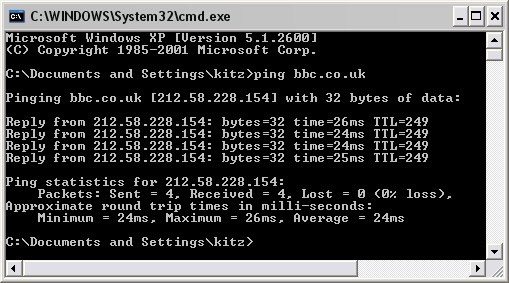PING is a utility that allows us to check if a specific IP address
is online or accessible and therefore used to help troubleshoot
network (or internet) connections.
It works by sending packet(s) of data to the IP address and checking
the response time.
Although there are various programs that will PING an IP address
for you, probably the quickest way for Windows users is to use the "ping"
command from the DOS prompt.
(Mac OS X and Linux users should use the Unix commands located here.)
To do this Start >>> run >>> type
"cmd"
Then from the prompt type "ping [IP address]".

Interpreting the results.
| Reply from 212.58.228.154
|
The host IP no that responded
|
| bytes=32
|
No of bytes sent in the packet |
| time=24ms
|
Time in milliseconds to reach the host |
| TTL=249 |
Time To Live. - Indication of hops along the way.* |
| Packets sent |
Total no of packets sent during the test |
| Packets received |
No of packets received by the host |
| Packets lost |
No of packets not received (lost on the way) |
Tips
The time taken for a packet to reach the host is also
called latency. This response is an indication of the round trip
to the host, and may involve a series of hops along the way.
Depending upon the location of the remote host, a good time would
be less than 100ms (0.1 second).
If you see a variation in the times this is called
latency "jitter", and you may receive poor communication
with the host.
A response of "Request timed out" means
there was no response in the default time period of one second.
If the latency of the response is more than one second, try using
the -w option on the ping command to increase the time-out.
For e.g. try "ping -w 5000 [IP address]" to allow responses
within 5 seconds.
*TTL
Every ping packet that is sent out has a TTL value
which by default is 255.
For every router hop that the packet passes through, the TTL figure
gets decreased by one.
So in the example above the TTL of 249 means (255 - 249) 6 hops.
Variations in the TTL show that the packets are traversing different
routes which isn't really a good thing :/
Although the default Unix ICMP echo_request is 255, some remote hosts (servers) may have their TTL response value set to 128 or 64, so you may have to adjust the calculation accordingly.
PING Commands
syntax
PING [options] destination_host
| Options |
| -a |
|
Resolve address to hostname. |
| -f |
|
Set "Don't fragment flag" in packet. |
| -i |
TTL |
Time To Live. |
| -j |
host-list |
Loose source route along host-list. |
| -k |
host-list |
Strict source route along host-list. |
| -l |
size |
Send buffer size. |
| -n |
count |
Number of echo requests to send. |
| -r |
count |
Record route for count hops |
| -s |
count |
Timestamp for count hops. |
| -t |
|
Pings the specified host until interrupted. |
| -v |
TOS |
Type Of Service. |
| -w |
timeout |
Timeout in milliseconds to wait for each reply. |
| |
|
|
| Commands |
| Ctrl + Break |
To see statistics and continue |
| Ctrl + C |
Stop Ping |
| > c:\filename.txt |
Send results to a text file |
| |
|
ss.64.com
The
story of the Ping Program
|


